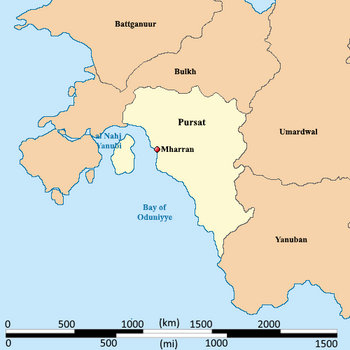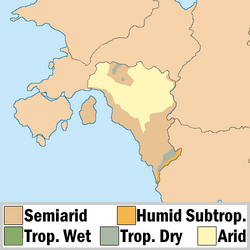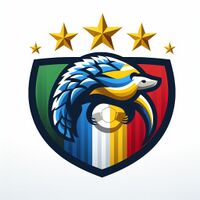Pursat
This article is a work-in-progress because it is incomplete and pending further input from an author. Note: The contents of this article are not considered canonical and may be inaccurate. Please comment on this article's talk page to share your input, comments and questions. |
Muwahhidnn State of Pursat Pursat | |
|---|---|
|
Flag | |
Motto: Freedom at last | |
 Map of Pursat | |
| Capital and | Mharran |
| Pursi, Burgoignesc | Arabic |
| Ethnic groups | Druze |
| Demonym(s) | Pursatnieen |
| Government | Theocracy |
| Establishment | |
• Independence from the MNLC | 1822 |
| Area | |
• | 610,667.397 km2 (235,780.000 sq mi) |
| Population | |
• Estimate | 504,569,500 |
• Density | 826.259/km2 (2,140.0/sq mi) |
| GDP (nominal) | estimate |
• Total | $6,358,080,269,500 |
• Per capita | $12,601 |
| Currency | Pursatni Taler (PT) |
• Summer (DST) | UTC+0 |
| Date format | dd-mm-yy |
| Driving side | right side |
| ISO 3166 code' | P₮ |
The Muwahhidnn State of Pursat, often just called Pursat, is a rapidly modernizing nation in southwestern Daria region of Audonia bordered by the Bay of Oduniyye in the west, Bulkh in the north, Umardwal and Yanuban in the east and south. It was massively urbanized in the 1980s and 90s and has a very high population for its landmass. Its executive is a president for life, but it does hold democratic elections for its legislative branch and local offices.
Pursat is a member of many international organizations like the League of Nations, the ISO, Red Crescent International, etc. and many other regulatory and economic bodies.
It is a market economy focused on exports, under the watchful eye of Burgundie, whose companies have a massive stake in the country's economic activity. It specializes in the assembly of microprocessors and cellphones, as well as the cultivation of tropical hard woods, fishing, and rubber, which also constitutes its major exports.
The people of Pursat are predominantly culturally Touareg, speak Pursi, and most practice Druzism.
Etymology
Pursat is a transliteration of the Aramaic word pirsa meaning lust with the tay merbutah the final "t" sound meaning the place lusted after. It was referred to as such because of its beautiful landscape and rich resources. Some scholars have postulated that it could have been the location of the real life inspiration for the Biblical Garden of Eden.
Geography and climate

Pursat has a tropical climate with two seasons, a wet season from October to March and a dry season from April to September. Climatic conditions vary depending on altitude. Rainfall is heavy along the coast and decreases in the north and south.
Annual precipitation varies from 500 to 900 mm (19.7 to 35.4 in) depending on the region with an average of 590 mm (23.2 in). Cyclones are also common during the wet season. Average temperature ranges in Mharran are from 13 to 24 °C (55.4 to 75.2 °F) in July to 22 to 31 °C (71.6 to 87.8 °F) in February.
| Climate data for Mharran | |||||||||||||
|---|---|---|---|---|---|---|---|---|---|---|---|---|---|
| Month | Jan | Feb | Mar | Apr | May | Jun | Jul | Aug | Sep | Oct | Nov | Dec | Year |
| Average high °C (°F) | 29.9 (85.8) |
29.6 (85.3) |
29.3 (84.7) |
27.8 (82.0) |
26.4 (79.5) |
24.6 (76.3) |
24.4 (75.9) |
25.3 (77.5) |
26.1 (79.0) |
26.5 (79.7) |
27.4 (81.3) |
29.1 (84.4) |
27.2 (81.0) |
| Daily mean °C (°F) | 26.3 (79.3) |
26.2 (79.2) |
25.6 (78.1) |
23.5 (74.3) |
21.4 (70.5) |
18.9 (66.0) |
18.8 (65.8) |
20.0 (68.0) |
21.5 (70.7) |
22.4 (72.3) |
23.8 (74.8) |
25.5 (77.9) |
22.8 (73.0) |
| Average low °C (°F) | 22.3 (72.1) |
22.3 (72.1) |
21.5 (70.7) |
19.4 (66.9) |
16.9 (62.4) |
14.4 (57.9) |
14.2 (57.6) |
15.4 (59.7) |
17.2 (63.0) |
18.3 (64.9) |
19.7 (67.5) |
21.4 (70.5) |
18.6 (65.5) |
| Average precipitation mm (inches) | 171.1 (6.74) |
130.5 (5.14) |
105.6 (4.16) |
56.5 (2.22) |
31.9 (1.26) |
17.6 (0.69) |
19.6 (0.77) |
15.0 (0.59) |
44.4 (1.75) |
54.7 (2.15) |
81.7 (3.22) |
85.0 (3.35) |
813.6 (32.04) |
| Average precipitation days (≥ 1.0 mm) | 8.1 | 7.6 | 7.0 | 4.4 | 2.8 | 2.4 | 1.8 | 2.2 | 3.2 | 5.5 | 7.9 | 7.5 | 60.4 |
| Average relative humidity (%) | 76 | 76 | 77 | 76 | 74 | 73 | 72 | 71 | 73 | 75 | 75 | 74 | 74 |
| Mean monthly sunshine hours | 223 | 210 | 225 | 229 | 253 | 246 | 256 | 252 | 228 | 210 | 198 | 220 | 2,750 |
| Source: ur mom | |||||||||||||
History
Contemporary period
Culture
Pursat's cultural is a unique amalgam of native ancient Druze, medieval Arabic, and early-modern Occidental cultures that have layered on top of each othe over the last millennium. {wp|Druzism}}, the majority faith, permeates daily life with its unique rituals and beliefs, celebrated in festivals like Ziyarat al-Nabi Shu'ayb, where Druze pilgrims journey to the holy site of Nabi Shu'ayb. The Oddiyad Caliphate brought Islam and Muslim architecture and the observance of high holidays like Ramadan, during the medieval period.
Pursat's cuisine is based on Touareg staples like taguella stew. Ebidi dishes like fufu and peanut soup, brought by the colonial-era slavery network and Arabic spices and ingredients like cumin, coriander, and dates have also become regular aspects of Pursat cuisine.
Historically literature was not a major aspect of Pursatieen culture. Oral storytelling, passed down through generations of Touaregs and while they still remain an important cultural aspect of Pursatieen life, written works in Pursi, Arabic, and Burgoignesc became a part of the ouvre during the colonial-era. Pursatnieen literature often explores themes of identity, cultural preservation, and the challenges of modernization. Art in Pursat thrives with lots of government subsidization. Intricate Touareg jewelry, made of locally sourced gold and semi-precious stones are internationally recognized signs of Pursat. Attire in Pursat draws on Audonian traditionalism and Occidental modernity. Touareg men often wear the distinctive tagelmust, a blue veil that protects from the harsh desert sun, while women wear colorful headscarves and intricate silver jewelry. Ebidi women favor vibrant patterns and flowing fabrics, while men often wear dashikis or embroidered tunics. Western-style clothing is also common, particularly in urban areas.
Sport
Pursatni Pangolins

The national WAFF league soccer team of Pursat are the Pursatni Pangolins.
Demographics
Self-reported ethnic origin in Pursat (2030)
The Touareg are the largest ethnic group, comprising 73.6% of the populace. The Ebidi, make up a significant 14.7% minority, while Arabs, historically linked to trade and migration in Daria, account for 6.3%. Occidentals, primarily of Bergendii descent and connected to historical colonial ties and economic partnerships, represent 2.4% of the population. The remaining 3% is a mix of various ethnicities. Pursi is the dominant native language, spoken by the majority. Burgoignesc is widely used in commerce, education, and government due to historical ties with Burgundie. Arabic holds significance as a liturgical language for the Muslim minority and is also used in trade and cultural exchange. Druzism is the majority faith, deeply embedded in the social fabric. A significant minority practices Islam, primarily Sunni, while a smaller population, mainly Occidental expatriates and converts, follow Christianity. The late 20th century saw rapid urbanization, resulting in high population density, particularly in the capital city, Mharran.
Economy
Pursat's tropical climate allows for a diverse range of agricultural activities. In the fertile lowlands, farmers cultivate like millet, sorghum, guar, and cassava, while terraced fields in the highlands are used for long grain rice and vegetable cultivation. Nomadic herders in the northern steppes raise livestock such as camels, goats, and sheep but due to the small scale and nomadic lifestyle these rarely make it to export markets and are consumed locally. The country possesses significant mineral resources, including copper, gold, and phosphates. Mining operations contribute to the country's export earnings, and are a major employer for the country. The financial sector is rapidly evolving, with the establishment of modern banking institutions and the growth of microfinance initiatives with investments primarily coming from Burgundie. While traditional financial practices like hawala remain prevalent in some areas, the government is actively promoting financial inclusion and modernization. The manufacturing sector is primarily focused on the assembly of electronics, particularly microprocessors and cellphones. This industry has benefited from foreign investment, primarily from Burgundie, and technology transfer, contributing to the country's economic growth and diversification. The government of Pursat hosts workshops for native skilled artisans to produce intricate textiles (rugs, wool, and tanned leather), traditional pottery (tagines in particular), jewelry, and camel and goat leather goods, which are sought after by both domestic and international consumers. Pursat's government is working with domestic and international companies to invest in tourism infrastructure that will lean into the purported Biblical connections and become a hotspot for Christian pilgrims and religious tourism. Pursat's coastline offers abundant fishing opportunities, supporting both local fishing communities and a growing aquaculture industry. Deep-sea fishing vessels primarily catch tuna and other pelagic fish, while coastal communities engage in artisanal fishing practices. Aquaculture farms, particularly shrimp farms, have emerged as a significant contributor to seafood exports. As global awareness of environmental issues grows, Pursat is actively developing its green sector. Investments in renewable energy sources like solar and wind power are reducing the country's reliance on fossil fuels, but these efforts are still nascent.
Infrastructure
Rail
Pursat uses Standard gauge, 1,435 mm (4 ft 8+1⁄2 in) as most of its rail infrastructure has been under the auspices of Burgundie and its sphere of influence in the Middle seas region, who all use that rail gauge.
Roads
Louage
A louage is a minibus shared taxi in many parts of Daria that were colonized by Burgundie. In Burgoignesc, the name means "rental." Departing only when filled with passengers not at specific times, they can be hired at stations. Louage ply set routes, and fares are set by the government. In contrast to other share taxis in Audonia, louage are sparsely decorated. Louages use a color-coding system to show customers what type of transport they provide and the destination of the vehicle. Louages with red lettering travel from one state to another, blue travel from city to city within a state, and yellow serves rural locales. Fares are purchased from ticket agents who walk throughout the louage stations or stands. Typical vehicles include: the MILCAR Jornalero, the TerreRaubeuer Valliant 130, and the CTC M237-07.
Power and electricity
See also








